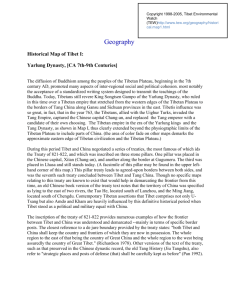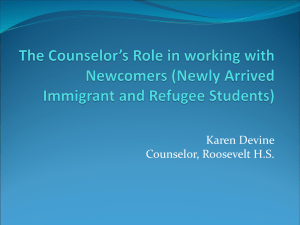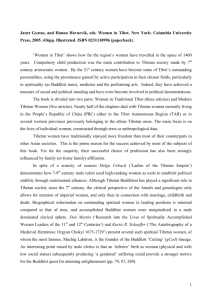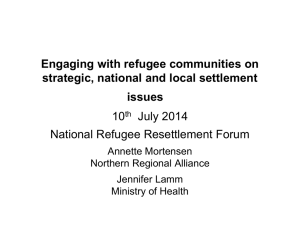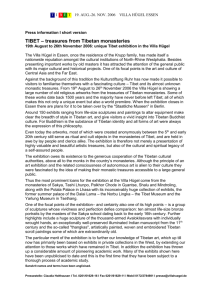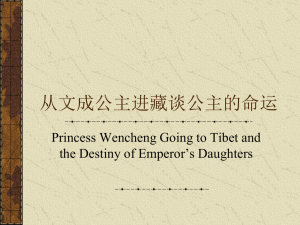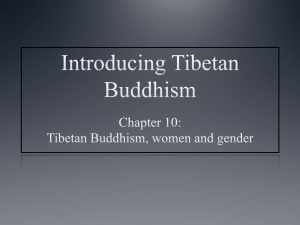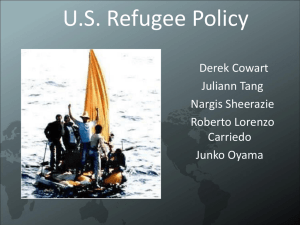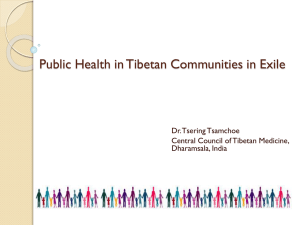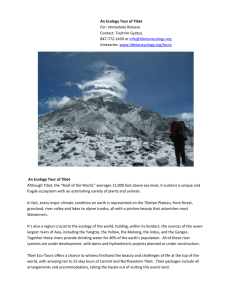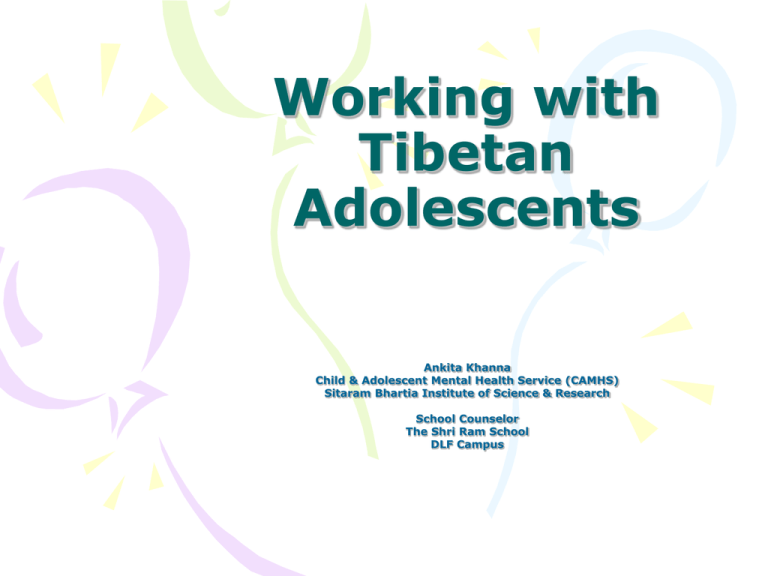
Working with
Tibetan
Adolescents
Ankita Khanna
Child & Adolescent Mental Health Service (CAMHS)
Sitaram Bhartia Institute of Science & Research
School Counselor
The Shri Ram School
DLF Campus
Understanding Adolescence
• Brain Wiring
• Physiological changes
• Peer group
• Sex
• Life style
• Cultural context
• School
• Family
Adolescent Brain “Work in
Progress”
• Myth of raging hormones
• Pruning- loss of substantial neural connections (20 billion
synapses)
• Immature frontal lobe impacting
– Clear thinking, control
– Executive functions
– High level reasoning and decision making
– Manage emotional circuit
• Vital part of growing up
• Clearing out of weak connections to make way for more
efficient information processing in adults
• May affect the way they manage emotions, thinking,
decision making, impulsivity
• Frontal lobes not fully mature until the age of 20
What is ‘normal’?
•
•
•
•
•
•
•
Rebellion
Defiance
Rudeness/talking back
Mood swings
Risk taking/experimenting
Lying
Crossing limits/breaking rules
Issues of Sexuality
• Awareness
• Orientation
• Confusion
• Experimentation
• Need for “unconditional acceptance &
love”
Peer Group – New Umbilical
Cord
• Only place they perceive they are not
being judged
• Addictive
• Rules of the Game -Either you are
“in” or “out”
• “Unconditional love”
A World of Their
Own: An
Exploration into
the Lives of
Tibetan Refugee
Adolescents
A research project submitted to the
University of Delhi for the M.A
(Psychology) Program, 2005-2007
Ankita Khanna
Background
• Classical child development theory has
been guided by an assumption of
homogeneity
• Utopian notion of a ‘normal’ childhood in a
safe and nurturing family environment
• Need for psychological research to
recognize, and give a voice to, these
diverse and unique childhood experiences.
The Study
• The present study aimed at exploring the
lived experiences of six Tibetan refugee
adolescents in exile. Using a host of
qualitative tools, including interviews,
focus groups, drawings and writings, an
attempt was made to capture the
experiential realities of this young refugee
group.
Why Tibetan adolescents?
• A group negotiating with a cross-section of
experiences of transience, both
developmentally (adolescence) as well as
politically (refugee hood)
• Unique in their position within the Tibetan
refugee community: came to India as
unaccompanied minors, have spent a part of their
lives in Tibet, and were sent, at varying ages, to
India by their families, in the hope of a better
future and a good education for them. These
children have had almost no contact with their
families over the years, and are growing up
under the care of the Tibetan government and its
organizations.
Preliminary Research
Questions
• How do these children negotiate with the
developmental challenges of adolescence,
and the challenges of their politically
unstable lives as refugees?
• How do identities evolve in a life
characterized by statelessness?
• How has their relationship with their
families and their country changed in their
minds over the years of no contact with
either?
• Is there an image of ‘home’ and ‘family’ in
exile that has replaced the real one?
Themes uncovered
• Remembering the past:
• A vivid account of the carefree pleasures
childhood in Tibet.
• Images of a serene and beautiful
landscape, where life was good and
everybody was happy.
• ‘Nostalgia’
• Life in Exile:
• Expectations from the host country: the
‘promised land’
• Long and difficult journey across borders
• Series of displacements: lack of a sense of
agency
• Trying to re-establish a sense of ‘home’
and ‘family’ in the foster homes
• High sense of gratitude towards own
community and leader, and the host
community
• Sense of being
disadvantaged/discriminated against
• Resignation/passive acceptance
• Self & Nation: “Me and my country”
• Self and country inseparable; the larger
Tibetan self always precedes the personal
self
• imprints of a disjunctive, authoritarian
Communist regime
• How they view the Chinese: anger,
resentment, at the same time not
necessarily as ‘the enemies’
• The oppressor as strong and allpowerful, the Tibetans as weak and
defenseless
• Visions of Tibet’s future:
hopeful/uncertain
• Notion of ‘return’: all the participants
were unanimous in their firm
assertion that they did not want to
return to their homeland for good.
• In search of Self: ‘Who am I?’
• Struggling with questions of identity
and belonging
• Being a ’refugee’ most salient part of
identity
• Personal aspirations represent a
concern for the collective
• Boundaries between personal and
collective are blurred
Who am I?
I am a girl from Tibet who don’t have
a land to call my homeland
I am a girl from Tibet where I don’t
have a home to call my home
I am a girl from Tibet and I left my
heart and soul over there.
Namlha, Age 18
Who am I?
This question comes again and again
Into my peaceful mind
And breaks the tranquility of my mind
But who really I am?
“Refugee!”
My inner voice quoth
Phunrap, Age 16
• These young refugees often come
under intense but opposing
pressures in asserting their sense of
Self. Life within the exiled
community necessitates that they
retain the Tibetan identity while the
challenges of their particular life
stage presses them to evolve a
distinct identity of their own.
• In the in-between spaces, this group of
young people negotiate and assert a sense
of selfhood, an identity uniquely theirs and
different from their parents’, from the
homeland, and from the larger diaspora
consciousness. Like tender plants that are
capable of taking root in a new soil, this
group of children seems to have created
“a world of their own”, with their own
joys, struggles, hopes and dreams.
Implications of the study
• Provides a psychological lens through which
to look at the real, qualitative concerns and
realities of this particular group.
• The need to look at, and give voice to, the
experiences and expressions of children.
• Looking at a cross-section of experiences of
transience, both developmentally
(adolescence) as well as politically (refugee
hood)Therapeutic implications: using group
work with refugee children & adolescents
Working with Adolescents
•
•
“Just try it out…..there is no harm in meeting”
Gradual work
•
•
•
•
•
•
•
•
•
•
•
•
•
Self disclosure
It’s OK to be wacky & bizarre
Body language
Language
Confidentiality
Genuineness
Respect
Clarify responsibility as a therapist
Connecting with his/her interest
Anything you do, try not getting shocked…
Be naturally curious to explore their world
Message…I am on your side
Once they understand that ……..you can try out any technique
– First individual
– Then with somebody he/she feels comfortable with
– The whole family
“You may give them your love but not your thoughts.
For they have their own thoughts.
You may house their bodies but not their souls, For
their souls dwell in the house of tomorrow, which
you cannot visit, not even in your dreams.
You may strive to be like them, but seek not to make
them like you. For life goes not backward nor tarries
with yesterday.
You are the bows from which your children as living
arrows spring forth”
Kahlil Gibran

